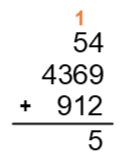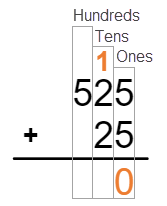Introduction
In this lesson, you will learn about the steps of addition. The pattern used to do addition is the same no matter how many digits are in the numbers, or how many numbers are being added together.
This video illustrates the lesson material below. Watching the video is optional.
Steps for Addition
- Stack the numbers according to place value.
- Add the numbers by column, starting on the right.
- Carry numbers to the left place value, as needed.
- Repeat steps 1–3 for each remaining column.
Example 1
\(6437+5639\)
First, stack the numbers according to place value. It doesn’t matter which number goes on top, only that the numbers are lined up by place value and aligned to the right.

Figure 1
Second, add the numbers by column. Always start on the right side of the equation, which means the numbers in the ones column. In the ones place is \(7+9\), which equals 16. This means there are 16 ones, or 1 ten and 6 ones. Carry the 1 ten to the tens column and place the 6 ones as part of the answer, right below the line in the ones column.

Figure 2
Next, add the tens column: \(1+3+3=7\). Notice that this answer, 7, is only one digit, which means it can be placed to the left of the 6 in the answer.

Figure 3
Next, add the hundreds place: \(4+6=10\). This translates to 0 hundreds and 1 thousand. The 1 thousand needs to be carried over to the thousands place, while the 0 can be placed to the left of the 7 in the answer.

Figure 4
Lastly, add the thousands: \(1+6+5=12\). This means there are 2 thousands and 1 ten thousand. Since there is nothing in the 10 thousands column, simply write the number 12 into the answer, to the left of the 0.
The complete answer is \(6437+5639=12076\).

Figure 5
Example 2
\(54+4369+912\)
Notice the first step has already been completed by stacking the numbers according to their place value.

Figure 6
Do steps two and three, beginning by adding the ones column: \(4+9+2=15\). Drop the 5 below the equation in the one's column. Carry the 1 over to the tens place, to be added in the proper column.

Figure 7
Now add the tens column: \(1+5+6+1=13\). Drop the 3 below the equation, placing it in the ten’s column, to the left of the 5. The 1 will be carried over to the hundred's column.

Figure 8
Add the hundreds column: \(1+3+9=13\). Drop the 3, to the left of the other numbers in the answer and carry the 1 over to the thousands place.

Figure 9
Finally, add the thousands column: \(1+4=5\). Drop the 5 to the left of the numbers in the answer, completing the solution: \(54+4369+912=5335\).

Figure 10
Things to Remember
- The steps for addition:
- Stack by place value
- Add by column, starting on the right
- Carry over numbers, as needed
- Repeat for each column, left to right
Practice Problems
Evaluate the following expressions:- \(62 + 33 = ?\) (
- \(525 + 25 = ?\) (
- \(19 + 52 + 61 = ?\) (
- \(637 + 400 = ?\) (
- \(710 + 231 = ?\) (
- \(968 + 875 + 682 = ?\) (
Need More Help?
- Study other Math Lessons in the Resource Center.
- Visit the Online Tutoring Resources in the Resource Center.
- Contact your Instructor.
- If you still need help, Schedule a Tutor.









